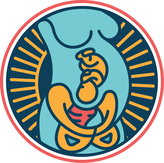|
Blossoming Bellies and Brittany Sharpe McCollum do not endorse any of the following companies or products. Any links offered in the email are affiliated with the author of the post, not affiliated with Blossoming Bellies Wholistic Birth Services or Brittany Sharpe McCollum. During the transitional fourth trimester, lots of changes are happening in your body and mind. While the baby’s well-being may be at the forefront of your mind, it’s important to prioritize your own physical and mental health during this crucial stage. A new parent may not see a clinical provider for up to six weeks after childbirth, and the body needs some TLC. Staying hydrated, maintaining a healthy diet, and taking advantage of the support of family and friends will be fundamental to regaining strength. Your core muscles have done a lot of hard work to grow and bring your baby into the world. Ligaments that have stretched and softened are now beginning to shrink and firm up. Your center of gravity has shifted again, and your posture is being impacted by all the time spent lifting and holding your baby. Maintaining good posture is particularly difficult in the postpartum period because of the lack of core strength in the first several weeks. Your abdominal muscles need a chance to stabilize and come back together to form a strong core. The good news is there are plenty of ways to support all of these changes during the postpartum period. Postpartum Exercise I get lots of questions about how and when to exercise after having a baby. I always recommend the 5-5-5 activity rule for my clients after the birth of their baby: 5 days in bed, 5 days around the bed, 5 days around the house. Your body has been working so hard for the last 9 to 10 months and needs time to recover! Generally speaking, about 2 weeks after an uncomplicated vaginal birth is a good time to start incorporating daily practices like breathing exercises, pelvic tilts, Kegels, walking, and arm/shoulder stretches. Exercise can be a great way to help strengthen and tighten stretched out muscles, improve or correct diastasis recti, and help get you back into the swing of things. Diastasis recti is the separation of the muscles along the middle of the abdomen that happens naturally during pregnancy to make room for a growing baby. A thin line of connective tissue called the linea alba lies between the two rows of the abdominal muscle and it stretches to allow the muscles to pull apart. giving birth, often the connective tissue will shrink and tighten up, pulling the muscles back together. While the condition sometimes corrects itself, other times it needs special attention. There are plenty of online programs that are geared towards helping improve or fix diastasis recti. If you are less than 6 weeks postpartum, I recommend working on not breathing into your belly (your ribs and chest should move more with each breath and your belly should not move much at all) and maintaining good posture while you are sitting and bending over, as these simple habits encourage a strong core. Maternity Compression The use of a postpartum recovery garment during the initial postpartum period is also super helpful in bringing your abdominal muscles back together and encouraging good posture. Many people are familiar with some form of maternity compression, like pregnancy support bands and compression socks. They may be less familiar, though, with how compression can help support the postpartum body. Like a pregnancy support band, a postpartum recovery garment provides gentle compression to the core but extends to encompass the upper thighs, posterior, and the top of the abdomen as well. Postpartum recovery garments should not be confused with shapewear or Spanx. Shapewear is designed for side slimming, not for providing support to your abdominal muscles after you’ve had a baby. During the postpartum period, side slimming garments put an increased pressure on the pelvic floor. Your pelvic floor has been relaxed and stretched during pregnancy. It is not in any condition to support an increased workload, as this can lead to prolapses and hernias. A postpartum recovery garment supports your abdominal muscles, stabilizes joints, and encourages your organs to settle back into their normal positions. Seeing as you now may be hunched over for a good portion of the day as you feed and care for your baby, your posture can suffer. As your muscles and ligaments firm back up, compression can ensure your spine is in proper alignment while that happens. You’ll be setting yourself up for better posture—and fewer aches and pains. There are a few considerations to keep in mind when wearing a postpartum recovery garment: ● Don’t wear the garment too tightly. It should not hurt or be difficult for you to breathe normally. Gentle support is what you’re aiming for! ● Don’t forget the importance of keeping good posture throughout the day. ● Check to see if maternity compression may be covered by your insurance provider.  Rebekah Mustaleski is Compression Director with MotifMedical.com and a Certified Professional Midwife with Roots & Wings Midwifery in Knoxville, TN, where she promotes evidence-based maternity care for families seeking an out of hospital delivery. She is working to improve maternal outcomes during the childbearing year and to promote a sustainable business model for midwifery practices across the country. Rebekah is co-owner of Roots & Wings Midwifery, LLC as well as Treasurer for the Tennessee Midwives Association.
4 Comments
6/12/2020 12:38:00 pm
This article was super helpful irrespective if you want to read a detailed guide on arlo pro vs arlo pro 2 , you can check it out here
Reply
10/13/2021 06:53:07 pm
Great tip about how vaginal births can sometimes be complicated. My sister had a bad delivery and tore. I should get her a doctor for postpartum care.
Reply
11/28/2022 03:30:56 pm
A few days ago, my sister found out that she's pregnant, and my whole family is very happy about the news. We want to help my sister with anything she needs, and your article seems like it has great information about recovering from birth, so I'll email it to my sister now. Thanks for the intake on letting your body rest after your birth and taking your time before starting to exercise again.
Reply
2/28/2023 02:14:27 am
Great Article! Thank you for sharing this is very informative post about postpartum recovery tips. Looking forward to the next one
Reply
Leave a Reply. |
AuthorAs the Philadelphia birth world blooms bigger and brighter, I think it's time I start putting some of the insightful questions I've received and information I've research into a public journal. I hope you'll find this inspiring, empowering, and totally enjoyable. Archives
February 2021
Categories |

 RSS Feed
RSS Feed